"Wild English" summer school
English language lessons for people interested in nature
Using nature, wildlife and citizen science to teach English is a wonderful idea. However, there's a temporary problem: New UK rules from 2021 say that you can't come to the UK if the purpose of your visit is to study English with an independent teacher like me. This is part of Brexit. I'm sure these new rules will soon change. If you come to the UK for any other purpose, such as tourism, you can do recreational study during your visit. However, there will be no Wild English summer school in 2025.
Wild English summer school will be back in 2026!
Click for other ways to study English with me:
Study with me in Scotland; or
study online by Google Meet, Zoom or Skype; or ask me to travel to your community or business.
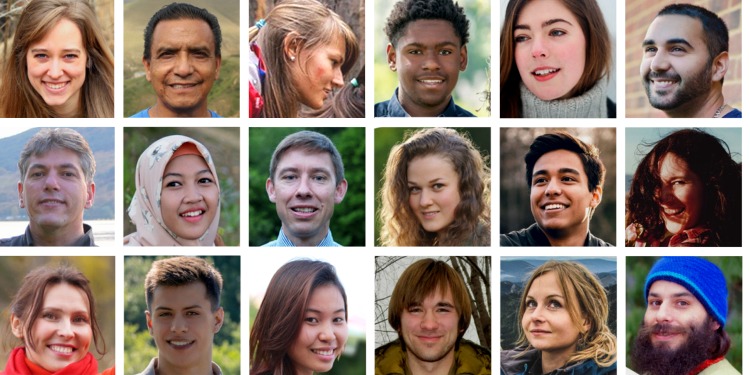
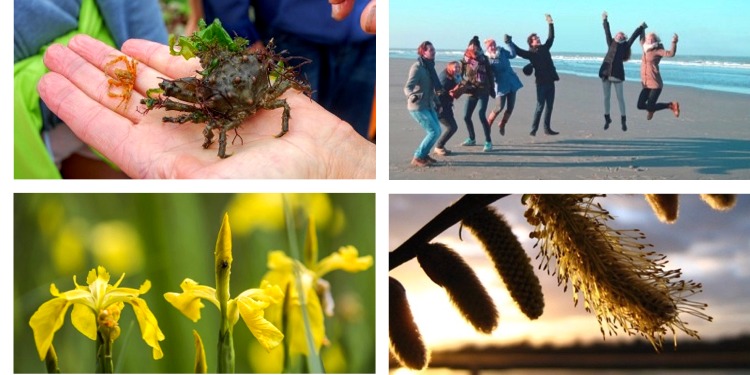
"Wild English": English language course for adults.
Theme: The natural world.
Place: An island on the west coast of Scotland.
Time: From March to the end of September: See dates
How much: £600 per week plus accommodation.
Lessons: 25 hours per week, Monday-Friday.
Max class size: 1 teacher to 8 students.
Learn because you love it
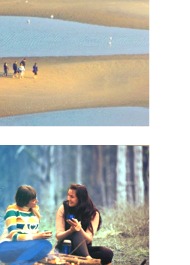 Motivation is essential for learning. If you enjoy your English course, you'll learn faster, you will learn more, and you will remember it longer.
Motivation is essential for learning. If you enjoy your English course, you'll learn faster, you will learn more, and you will remember it longer.
Language is for communication. An English teacher's main task is to motivate people to communicate in English. That means finding lesson themes that interest everybody on the course.
Typical lesson themes for general and business English courses are Making Friends (general English), Booking a Hotel Room (business English), etc.
Typical lesson themes on the Wild English course are How to Watch Seals, What do Insects Do?, Identifying Broadleaf Trees, Animal Camouflage, Sand Invertebrates, etc.
The Wild English course
The Wild English course is for everybody who likes nature and the beach.
You will walk in wild places, identify butterflies and discuss their secret lives, catch rotifers, and photograph plants. Maybe you live in a big city and have never seen a wild animal; maybe you're a professional naturalist. Everybody is welcome!
40% of our lessons happen on the beach or in the forest, where we do "citizen science" projects in a superb natural environment.
But it's not all walking around in the fresh air. It's an intensive English course, like the courses I've done for executives from Hitachi, HSBC, Renault, General Electric, EDF and so on. Back in the classroom, you will plan for a "citizen science" project, do a health & safety assessment, and create a web page. We also do traditional lessons on English grammar, vocabulary, pronunciation and writing.
The Wild English summer school is different
In or out of the classroom, all our lessons and activities are real, practical and useful. When we have a discussion, it's relevant: "What's the best way to organise our beach survey project?" or "When is it worth saving a species if their habitat has disappeared?"
We don't do the unreal classroom activities of a typical language school. We don't do things like "Describe your family", "Tell your neighbour about your last holiday", "Write a class newspaper", "Present an imaginary product" or "Role play a job interview."
We do real tasks like these, which are highly motivating. Everybody wants to understand what to do, everybody wants to communicate, and in the evening people still want to discuss the day's activities.
With real communication, confidence comes quickly.
"English is about communication. There must be something the student really wants to say, and something they really want to know."
The central lesson at the Summer School is that you can communicate in English. If you use the wrong tense, but everybody understands you, it isn't a problem. The wrong preposition? No problem. The wrong word order? No problem; we still understand you! You will be too busy and interested to worry about perfect grammar. And by the end of the course, you will have the confidence to communicate in English.
By Day 4 we have relaxed, happy students.
By Day 7, everybody is confident they can communicate.
By Day 10, you'll enjoy using English.
You'll produce real environmental data for scientists and for the local community. Every day, you'll learn a '30-minute skill' and then share it with others. You'll make new contacts, leave with great memories, and probably come back next year.
Examples of "citizen science" projects
- Environmental baseline survey (EBS) of beach transect.
- Headland survey of cetaceans.
- Square-metre survey of intertidal crustaceans and gastropods (barnacles and limpets)
- Make an Ocean Literacy web page about a local species.
- Visit a local nature reserve and collect data.
- And current projects of the Marine Biological Association, the Marine Conservation Society, Natural Scotland and Capturing Our Coast.
Examples of 30-minute skills. You learn them, then you teach them:
- Design and make the perfect salad.
- Make cheese scones.
- Make a Scottish speciality (cranachan, Cullen skink, rollmops, shortbread...)
- Map-reading.
- Sing a traditional song.
- Put on a First Aid bandage.
- Collect and cut wood for a fire - safely.
- Sharpen an axe.
- Calculate the height of a tree.
- Put a wildlife design on a T-shirt.
"For students of English, motivation + communication = confidence + competence."
Wolf Island, the Isle of Mull
The Wild English summer school is based on the wild, beautiful little Wolf Island, in the Atlantic Ocean off the west coast of Scotland. Wolf Island is 8km long and 4km wide. The human population of Wolf Island is just 12 people, and there are no cars on the island, just a few farm vehicles and some small electric vehicles for community use.
Wolf Island has no shops, and no pub, but there is a very good cafe/restaurant, and good internet. The east end of Wolf Island is partly farmland (the famous Highland cows with their long hair and long horns) and partly woodland, with fine mature trees of all kinds.
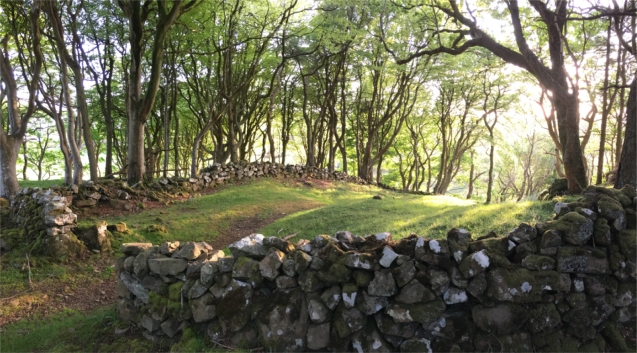
The west end of Wolf Island is the typical landscape of the Scottish Highlands & Islands, with very few trees, and several old villages that were abandoned in the 19th century. They are in beautiful locations.
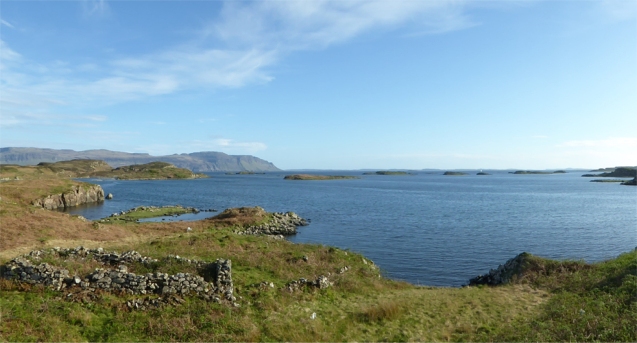
On land, Wolf Island has wonderful walks and views - see the photo gallery links below. It is in the Loch na Keal National Scenic Area. If you go walking, you are almost sure to see wild red deer, golden eagles, sea eagles, buzzards, hen harriers and many smaller birds and animals. In and on the sea there are seals, otters, dolphins, porpoises, and amazing sea birds such as gannets, black guillemots and puffins. You may be lucky and see a minke whale. Wildlife tour operators include Sea Life Surveys on Mull for whale-watching.
Photo gallery: Wolf Island - east.Photo gallery: Wolf Island - west. Wolf Island receives nearly 10,000 visitors per year. These are walkers and cyclists who cross the 300 metres of water from the Isle of Mull using Wolf Island's little ferry. Photo gallery: Isle of Mull #1.
Photo gallery: Isle of Mull #2.
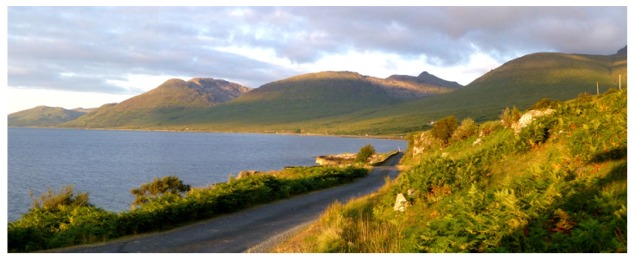
We will have day trips to explore Mull by road, but if you prefer a really wild island, you can choose to stay on Wolf Island for your entire visit. There's plenty to see and do!
Most visitors to these islands come to see the wildlife:
Photo gallery: The marine environment.Photo gallery: The sea shore.
Photo gallery: Terrestrial environment.
Some people visit Wolf Island just for its geology. The island is made of volcanic basalt, deposited in layers like a wedding cake, and the coast has plenty of basalt columns. Jules Verne, Felix Mendelssohn and many famous visitors have taken a boat trip from Wolf Island to the nearby small island of Staffa, to see its particularly fine basalt columns, and Fingal's Cave. Click here for a free publication by the British Geological Survey, "Mull & Iona: A Landscape Fashioned by Geology".
You can walk and do sea kayaking around Wolf Island all year round. There are lots of small islands, some only the size of a tennis court! Together, Wolf Island and the smaller islands are known as the Staffa Archipelago. They're perfect for exploring from a sea kayak. I have 7 kayaks, including some suitable for beginners.
There is plenty of history to see here too, from the remains of a Viking fortified house to the walls of villages abandoned during the Clearances of the 19th century. Some visitors to the area come because the small island of Iona, in the south of Mull, is one of the oldest Christian centres in western Europe, dating from the arrival of Saint Columba or Colmcille in 563 AD. Iona Abbey includes some of the Christian monastery that was built on the same site in 1204 AD.
Accommodation on the islands
The Wild English course is based on Wolf Island, with with day trips to the Isle of Mull (Tobermory, Dervaig, Calgary Bay and other beautiful places). You can stay either on Wolf Island itself, or on the Isle of Mull near Wolf Island Ferry (which is a 5-minute ferry crossing).
There is no hotel in this area, but there is a hostel; self-catering accommodation; bed & breakfasts; and it is sometimes possible to stay with a host family for £200 per week. A host family room is likely to be quite small and facilities may be basic. However, you will probably speak more English! If you want to stay with a host family, please ask us for details.
You can find your accommodation (except for host family accommodation, the Ardalum House hostel, and AirBnB rentals at Cragaig and Bearnus) through the Mull Visitor & Information Centre. Their website is here: www.isle-of-mull.net. Their email is: info [at] exploremull.com or you can telephone them on +44 1688 302875.
Travelling to the island
If you like the idea of a language course that's:
- Active
- Outdoor
- Good for the environment
- Great for your English
- Intensive
- Fun
...come and join us!
Find out more
Go to Wild English FAQs for answers to frequently-asked questions.
Go to Course Details to see prices, what's included and travel information.
Go to Terms & Conditions to read about deposits, cancellations and refunds.
Go to Enquiry Form to make an enquiry or booking.
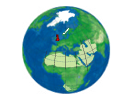 My name is Nicholas, and I'm an independent English teacher.
My name is Nicholas, and I'm an independent English teacher.
I work anywhere in the world.
Click here to read about me.
Click here to read about my prices and availability.
